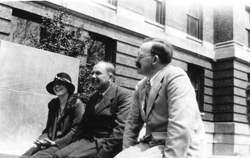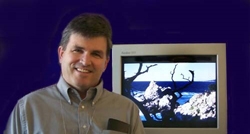By Amanda Nelson, Associate Archivist
In May, the Center for History of Physics sponsored three brown bag lunch talks at the American Center for Physics in College Park. These talks covered a wide range of topics including Charles Galton Darwin, the beginning of the National Center for Atmospheric Research (NCAR) in Boulder, Colorado, and Bruce Heezen and Marie Tharp’s work. Two were given by grant-in-aid recipients doing research in the Niels Bohr Library & Archives and the Washington, D.C. area. For more information on these talks please email the Center for History of Physics or see a list of past and future talks on our website.
Wednesday May 13, 2015 – Benjamin Johnson of the Fritz Haber Institute, Berlin Germany

Charles Galton Darwin and the statistical conservation of energy (1911-1927)
The development of quantum physics between 1900 and 1927 was the result of individual and combined efforts by many scientists, some of whom figure prominently into the history of the period and others have largely been forgotten. Charles Galton Darwin, although still recognized for several key mathematical achievements, also contributed greatly to the debates leading up to the formulation of quantum mechanics in 1927. Correspondence and scientific publication show that on the subject of conservation of energy during interactions of light and matter Darwin played a key role in influencing the thought of some of the most prominent scientists laboring on the subject, most notably Niels Bohr. Throughout the discussions of the topic up through the BKS Theory Darwin’s contributions can be found, although often not explicitly. While advocating only the requirement of a statistical conservation of energy in atomic processes, Darwin often relied on physical conceptions of joining classical wave trains and quantum discontinuities in a single model and the rejection of the possibility of a “frequency” associated with the quantum of light. His ideas were developed often in tandem with Niels Bohr, although Bohr often relied on philosophical causal arguments that the wave characteristics of light exclude the possibility of conservation of energy in, for example, the photoelectric effect. The story begins with the roots of Darwin’s thought through his examination of Planck’s radiation law in the 1910s, follows the scientist through the 1920s and the birth of quantum mechanics and ends in the early 1930s when physicists were left to deal with the aftermath of what they had discovered. Along the way, Darwin’s critical and voracious approach to science is highlighted as well as the contributions he made to the vast strides taken by physics in those years. The path traced by Darwin’s concepts of the statistical conservation of energy parallel the events leading to the discoveries of matrix and wave mechanics and illustrate in a succinct manner the changes that took place in this era.
Thursday May 14, 2015 – Joe Bassi of Embry-Riddle Aeronautical University

The Beginnings of a Scientific Peak: Post WWII Sun-Earth Connection Research in Boulder, Colorado
From being considered a “scientific Siberia” in the 1940s, Boulder developed into “AstroBoulder” by the early 60s. How does a small town in the foothills of the Rocky Mountains, home to only a middling state university, become a world center for space and atmospheric sciences in less than two decades? The answer to this question lies in the complex confluence of individual scientific ambitions relating to sun-earth connection research, the pre and early Cold War context of science in the US, and political machinations at various levels of government. This presentations lays out the early phases of this process, and particularly focuses on the efforts of solar astronomer Walter Orr Roberts, Colorado Senator “Big Ed” Johnson, the Boulder chamber of Commerce, and others in bringing sun-earth science to Boulder in the late 1940s and early 1950s. This investigation thereby sheds some light on the process by which scientific/academic centers (or “peaks”) are created.
Wednesday, May 27, 2015 – Skip Theberge of NOAA Central Library

Hunting the Rift – Finding Fracture Zones: The First Heezen-Tharp Map
Various histories, both in published books and found on the Internet, give Bruce Heezen, Marie Tharp, and Maurice Ewing credit for the discovery of the central rift valley of the Mid-Atlantic Ridge, and by extension the world-wide rift system. According to Heezen and Tharp, they discovered the rift valley both by developing bathymetric profiles of the North Atlantic seafloor and by tracking earthquake epicenters. However, a little known paper published prior to World War II by the German scientist Gunter Dietrich, clearly establishes Dietrich's priority of discovery of the Mid-Atlantic rift valley. It will be shown that Heezen was aware of this paper and engaged in a form of bathymetric plagiarism by following Dietrich's tracklines throughout the North Atlantic and claiming Dietrich's discoveries for himself and Marie Tharp. Ironically, in doing so, Heezen was the first to encounter large Atlantic fracture zones, but because of confusion and possibly fear of ridicule suppressed this information for over ten years. As a result, the first Physiographic Map of the Atlantic Ocean had errors approaching 100 nautical miles in the location of the rift valley and no indication of fracture zones. Heezen and Tharp ignored their own data in production of this map and followed the time-honored method of placing the legend over their area of greatest confusion. Surprisingly, Heezen's apparent fascination with Dietrich continued into the 1960's when he formed a polygon with ship trackline that enclosed Dietrich's "most striking depression" and declared the existence of the Kane Fracture Zone.
